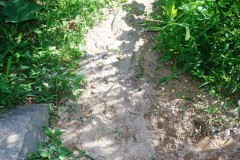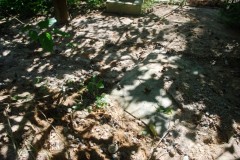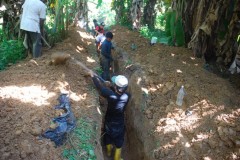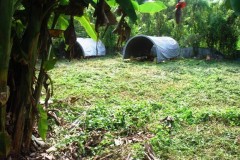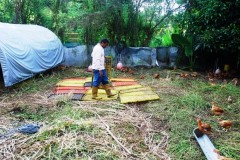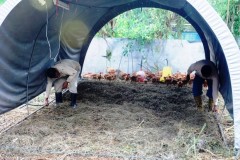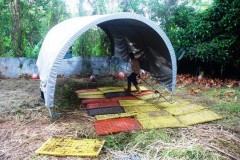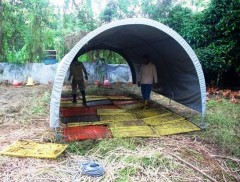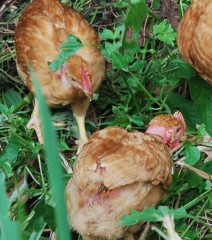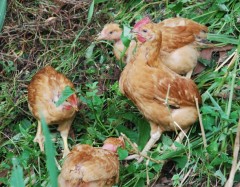May 24, 2010
Raising Free Range Chickens - Watch That Water!!!
People ask me what is the most important thing that they have to watch out for in successful free-range poultry raising in Malaysia and I always answer : water!
Watch out for water in the litter
Water in the reban
Water under the reban
Water in the padang
Watch out for leaking pipes, even in the fields as the birds will drink from the leaked water which will become contaminated from the dung.
Watch out for the temperature of the water - it must always be colder than the surrounding air.
Above all the farm must be dry. With our humidity, a wet farm will raise humidity to 70% plus. That will bring with it many diseases.
We shape the land by creating swales, retention ponds and contours to move rain water to areas away from the fields and coops.
But sometimes the volume is just too great and we have no choice but to cut the earth and make drains. This is what happened to us over the weekend. There was a sudden huge downpour and the chicken fields were flooded. One particular field with marketable size chickens was flooded 3 feet and 407 chickens drowned. That's a revenue loss of about RM8000.
Mud everywhere blocking off culverts and drains.
A drain buried in mud.
A field covered with mud.
We had no alternative but to dig a huge earth drain to handle similar volume in future.
The weather at the farm have changed in the past few years and coupled with land clearing nearby, the farm has become a focal point of run-offs from these cleared areas.
Though the work was tiring, the workers were cheerful. they had fun catching the many wild eels in the farm for their lunch and dinner.
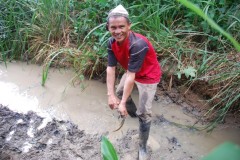
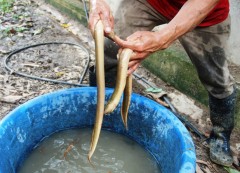
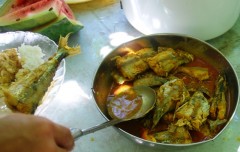
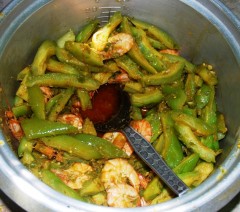
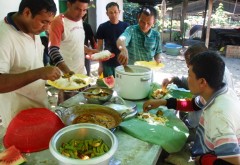
19:54 Posted in Chickens | Permalink | Comments (0) | Tags: hoop house, free-range chickens, crd, poultry disease, free range poultry system, grassfed chickens
May 10, 2010
Raising Free Range Chickens - Leave The Ammonia Behind!
Many readers write to us asking about diseases affecting their birds. However, many of these problems have to do with basic management, in particular the formation of ammonia(1) in their coops.
Initial signs of excessive ammonia include eye irritation and trachea and lung problems.
Subsequent to that, secondary infection sets in - mycoplasma for one, leading to chronic respiratory disease. Another common poultry problem is coryza resulting in a mad rush for antibiotics. Coryza, in the Malaysian context is often the result of exposure to ammonia which corrodes the mucous membrane allowing pathogens to gain entry into the body.
So the root cause is excessive ammonia and the solution to many diseases with symptoms like gasping, coryza, swollen eyes, etc is to manage ammonia production in your poultry system, rather than treat the end-result all the time, resulting in the abuse of antibiotics.
Ammonia production also leads to environmental issues - flies, smell, leachate, etc.
At our farm, we decided on a movable hoop house:
The hoop house design encourages air movement. The temperature difference within / outside the house can be as high as 2 degrees celcius.
The hoop house is moved every 7 to 10 days. During dry spells, 10 days. During rainy seasons, every 7 days. Feeders and waterers are moved every 3 days. Don't let dung and discarded food accumulate to form ammonia.
Lay down the bedding material.
The house can be pulled by one man if the move is on flat land. If it needs to be lifted, then two men is required.
Note that the old floor have been covered with dried grass to start the in-situ composting. In no time, humus will be formed.
Each hoop house is designed to shelter 300 800grams chickens from the sun and rain.
The house is moved in less than 15 mins. The chickens have clean fresh beds instantly. No necessity to remove litter and top up litter, etc resulting in labour and material costs savings.
DQ'S GOLDEN RULE : MOVE THE HOUSE, MOVE THE FEEDERS!! LEAVE THE AMMONIA BEHIND!!
Resulting in healthy, happy, nutritious chickens:
Birds are moved to the hoop house when they are 800 grams in size.
(1) The formation of ammonia is part of the natural process in the breakdown of organic material. Ammonium is poisonous and often wipe out a newly established aquarium of its fish. Industrial animal husbandry often raise animals in ammonia prone conditions - poultry, feedlotted cattle wading in their own dung, etc. Waste water from farms with animals often contain nitrites and nitrates which can also harm humans. At our farm all discharge is treated naturally and regularly tested for nitrite and nitrate levels as part of responsible farming.
17:13 Posted in Chickens | Permalink | Comments (1) | Tags: hoop house, free-range chickens, crd, poultry disease, free range poultry system, grassfed chickens









